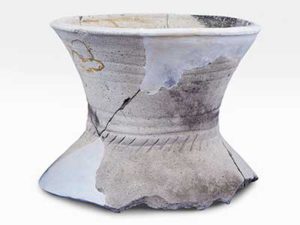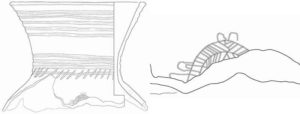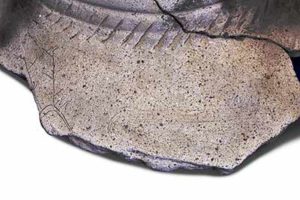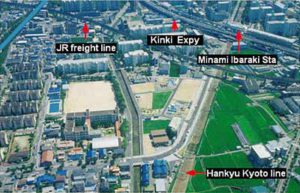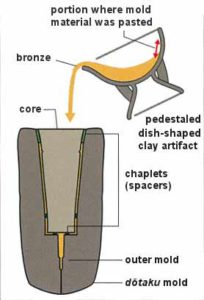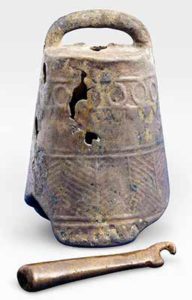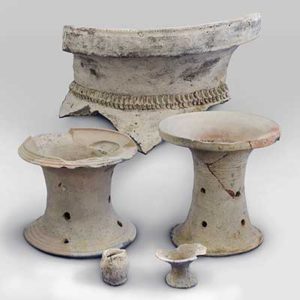Adapted from Hakkutsu sareta Nihon rettō 2015 [Excavations in the Japanese Archipelago, 2015] (Bunkachō [Agency for Cultural Affairs], ed., Kyodo News, 2015).
Dōtaku image-bearing pottery
A vase made in the latter portion of the Middle Yayoi period. Rim diameter is 26 cm. The dōtaku image was drawn on the body (in the area framed in blue). The bottom portion was not found.
Scale drawing of the dōtaku image
Scale drawing of the back side of the dōtaku image vase
Drawing on the back side of the dōtaku image vase
On the opposite side of the vase’s body from the dōtaku image, an animal thought to be a deer (left) and a flowing water pattern (right) are drawn. Both are motifs of drawings made on dōtaku, and it is inferred that the vase was used in dōtaku-related ritual.
Panoramic view of the site
Higashi Nara was the site of a large settlement maintained from the Early Yayoi (approximately 2,200 years ago) to the Kamakura (thirteenth century) periods, and its extent reaches approximately 1.4 km north–south and 1 km east–west (up to the blue line at upper left of the photo).
Adapted from Hakkutsu sareta Nihon rettō 2015 [Excavations in the Japanese Archipelago, 2015] (Bunkachō [Agency for Cultural Affairs], ed., Kyodo News, 2015).
Higashi Nara Site, Ibaraki City, Osaka Prefecture
Middle Yayoi period (approximately 2,000 years before the present)
Pottery drawn with a picture of a dōtaku
Located atop a slight rise extending tongue-like from the Senri hills in the northern part of Osaka prefecture, Higashi Nara is an exemplary large-scale settlement site of the Kinki region. Large amounts of artifacts related to casting, from the latter portion of the Middle Yayoi period (approximately 2,000 years before the present), have been found in the southeast portion, and it is known as a site where bronze implements centering on dōtaku (bronze bells) and glass objects were made.
In a reinvestigation conducted in recent years of the recovered artifacts, an image-bearing pot on which a dōtaku was drawn has been newly recognized. In addition to a large vase and vessel stands being found in the pit where the image-bearing pot was excavated, at a spot 70 m northwest of the pit, a small dōtaku was found at the bottom of a moat from the latter portion of the Middle Yayoi period. As they are of the same age and were moreover discovered in close proximity to each other, the pottery and small dōtaku are thought to have possibly been used in the same ritual.
In addition to the image-bearing pot, it has become clear that there were also items such as clay artifacts in the shape of pedestaled dishes, and molding material with adhesions of bronze. Such finds of artifacts related to casting grouped together are rare, and these will serve as important materials for investigating the casting technology of the time. (Shimizu Kunihiko)
Artifacts related to making Yayoi period dōtaku are recovered
Inferred use of pedestaled-dish-shaped clay artifact
Adapted from Hakkutsu sareta Nihon rettō 2015 [Excavations in the Japanese Archipelago, 2015] (Bunkachō [Agency for Cultural Affairs], ed., Kyodo News, 2015).
Discolored mold material with bronze adhesion
Gently curved in shape, it is thought to have been pasted onto the interior of the dish portion of the pedestaled-dish-shaped clay artifact.
Pedestaled-dish-shaped clay artifact
Inferred for use as a crucible or a ladle (a vessel for scooping up molten metal and pouring it into a mold). It is fitted with handles.
Small dōtaku (Higashi Nara Dōtaku)
Height: 14.4 cm; greatest width: 9.9 cm. From the oval-shaped cross section of handle and other features, the overall form is close to the Korean style small bronze bells thought to be the origin of dōtaku. As the patterns drawn on the body of the bell derive from those of pottery from the Final Jōmon period, this item is thought by some to have been made prior to the Middle Yayoi period when dōtaku were produced at the Higashi Nara site.
Pottery
A large-scale vase and vessel stands, plus miniature items, etc. These were found in the same place as the dōtaku-image vase, where they were possibly discarded after use in ritual.


